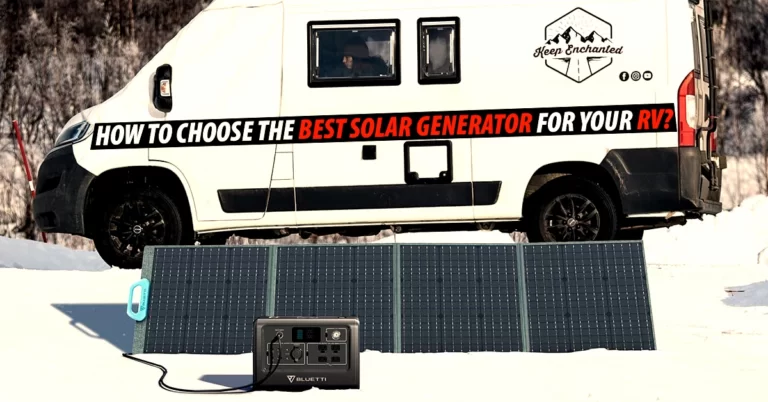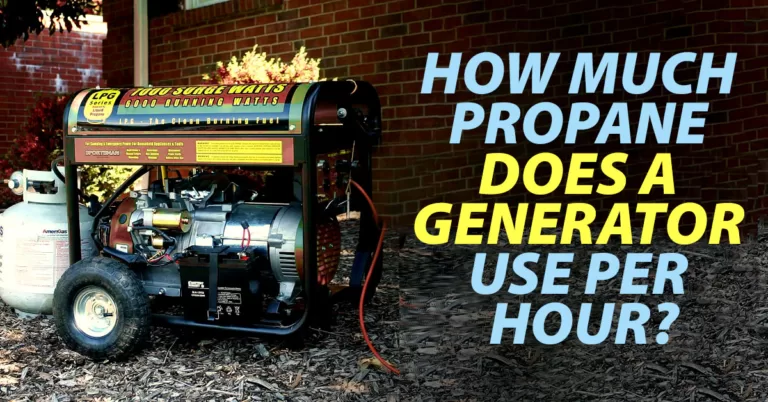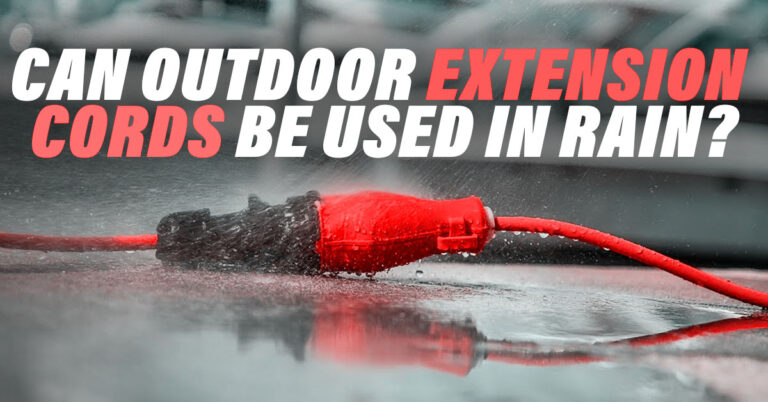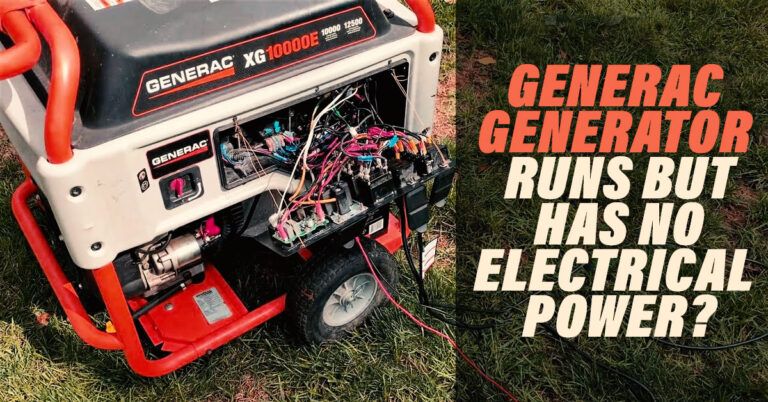How to Run A Generator In The Rain?
Generators are a vital source of energy when it comes to providing power in remote places or acting as a backup supply of electricity during blackouts. To safeguard both the user and the equipment, several safety precautions must be taken while using generators in wet weather. The answer to the frequently asked question of whether generators can get wet is that it depends on the type of generator and the application. We’ll examine the factors that determine whether a generator may become wet, and provide tips on how to use generators in the rain, snow, and other wet weather conditions without getting them wet.
Can Generators Get Wet?
Yes, a generator can get wet under certain conditions. Some generators are specifically designed for wet conditions and are equipped with waterproof or water-resistant enclosures to protect against moisture. These types of generators are generally safe to use in wet conditions, such as in the rain or snow.
If A Generator Gets Wet, What Happens?
If a generator becomes wet, both the user and the equipment might be in danger. Since water and electricity do not mix, using a wet generator might result in electrical shocks and equipment damage. It is essential to take the required actions to avoid utilizing a wet generator and to address any issues that could arise if one is used.
One of the major risks of utilizing a wet generator is electric shock. Any time a generator operator contacts a wet surface, they run the danger of being shocked since moist surfaces may transmit electricity. The risk is quite high if the generator is linked to a power source since the energy flowing through the equipment might be lethal.
The possibility of water entering the fuel or electrical systems might cause corrosion or rust. This might cause the generator to malfunction or break down, necessitating costly repairs.
If A Generator Becomes Wet, What Should I Do?
The following are the steps you should take if a generator becomes wet:
- Your first priority should be to shut off the generator and unhook it from all power sources, since doing so is essential for your security.
- Try not to use the generator if it is moist. Because of the potential for electrical shocks and equipment damage, this might endanger the operator.
- Look for any evident damage to the generator, such as water entering the fuel or electrical systems. Look for rust or corrosion on the generator’s outside, which might indicate that water has entered the mechanism.
- If you notice any damage, it is advisable to have a professional repair it rather than attempting to use the generator again. It might be dangerous and dangerously damaging to try to run a faulty generator.
- If the generator seems to be in great condition, you should fully dry it out before attempting to use it again. You may do this by using a dry cloth or towel to wipe any standing water from the generator’s surface.
- Dry out any electrical components that may have come into contact with water, as well as the fuel system. By doing this, the possibility of corrosion or rust, which might eventually affect the generator, may be reduced.
- Once the generator has dried, you should carefully follow the manufacturer’s instructions for starting and utilizing the equipment. This might include connecting the generator to a power source and refueling it, among other tasks.
- Any advisories or warnings that may appear on the generator’s control panel should be carefully observed. These can indicate problems that need to be addressed before using the generator.
- Keep a close watch on the generator while it’s operating and be sure to unplug it and switch it off if you notice any problems.
- In general, it’s best to avoid wet environments as much as possible while utilizing a generator. Nevertheless, if a generator does become wet, following the appropriate safety procedures might help shield both the user and the equipment.
Tips For Safely Running Generators In Wet Weather Or Conditions
Choose The Right Generator
Some generators are made specifically for usage in moist areas, such as those with waterproof or water-resistant casings. Since they are more likely to resist moist circumstances, these generators are safer to operate in rain or other wet conditions.
Keep The Generator Dry
Try your best to keep the generator as dry as you can, even if it is snowing or raining outside. To achieve this, cover the generator with a canopy or tarp to shield it from the elements. The generator may also be protected from the elements with a plastic cover.
Use Care While Handling Fuel
The most important component of a generator, fuel, may be dangerous if not handled appropriately. When fueling the generator in wet conditions, use caution to avoid spills or accidents. In case of a gasoline spill, a fire extinguisher should also be kept close by.
Properly Ground The Generator
The generator frame should be grounded, and a grounding wire should be routed from the rod to the generator. Proper grounding reduces the chance of electrical fires or shocks.
Follow The Instructions From The Manufacturer
Because each generator is different, it’s essential to start and operate the machinery according to the manufacturer’s instructions. If you notice any problems or malfunctions, be sure to shut off the generator immediately and pay heed to any alarms or warnings that may appear on the control panel.
While In Use, Keep The Generator Away From Water
As much as possible, keep the generator away from water sources like puddles or standing water. Electrical shocks and other risks may be less likely as a result.
Use Caution When Handling Electrical Cords
Use care while handling extension cables to avoid accidents. Utilize considerable care if you must use extension cables with your generator. Aim to keep cables away from puddles and other locations with standing water. Before connecting any wet wires to the generator or other equipment, Make sure that they are totally dry, and protect them from the rain.
These recommendations will enable you to safely operate a generator in wet conditions or in any weather while protecting both the user and the equipment. It is best to avoid running a generator in wet conditions wherever possible to reduce the risk of accidents or equipment failure.
How to Run a Generator in the Rain
You can use a generator when it’s raining by remembering the following advice:
Steel Shelter Enclosures
Generators may be kept in secure, inclement weather-resistant steel shelters. These enclosures are frequently made of tough materials and designed to withstand wet conditions. They could be a great option for long-term use or for protecting the generator in bad weather.
Use A Plastic Storage Shed
Plastic shelters are a transportable, lightweight option for shielding a generator from the elements. These waterproof shelters are often made of materials that are easy to install and dismantle. They could still be a great option for temporary use, even if they might not provide as much protection as a steel cage.
Pop-Up Canopy
Pop-up canopies are portable, tent-like coverings that may be placed over generators to shield them from the weather. Canopies are often made of materials that are water-resistant and designed for convenience. Even though they may not be as secure as a steel or plastic shed, they might still be a great option for a temporary building.
Plastic Cover
To keep the rain off the generator, plastic covers may be used. These solutions may be easily used and conveniently stowed when not in use, albeit they may not be as durable as other options.
Tarp
A tarp may be placed over the generator to keep the rain off of it. Tarps cannot provide the same level of protection as a canopy, even though they are often made of waterproof materials and are easy to use.
Shed Or Garage
To keep the weather off of the generator, it may be stored within a permanent structure like a shed or garage. This option provides the best protection, but it may not always be practical.
When determining how to run a generator in the rain, it is essential to consider the generator’s size and shape, as well as the duration and intensity of the rain. While steel enclosures and plastic sheds may be more suitable for long-term use, pop-up canopies and coverings may be more appropriate for short-term use.
It’s also important to follow the manufacturer’s instructions when utilizing a generator in wet conditions, since different generators may have specific requirements or limitations. By following these guidelines, you may safely run a generator in the rain while protecting both the equipment and the user from the elements.
How To Build A DIY Generator Cover To Prevent It From Getting Wet
You may construct your own enclosure if you need to use a generator in moist conditions without a shelter or enclosure to protect the equipment from the weather. Here are some steps to take while creating your own generator enclosure:
The Measurement Of The Generator
Measure the generator’s size and shape to determine the enclosure’s measurements. To run the generator, you must have enough space without being too tight or congested.
Collect Resources
You need to use a sturdy, water-resistant substance to construct the enclosure’s walls. You may cover it with canvas, tarps, or plastic sheeting. You will also need poles, stakes, or other items to support the enclosure.
Create The Frame
Using the objects you have gathered, create a frame for the enclosure. For this, stakes, poles, or other sturdy materials that can support the weight of the generator and the enclosure may be utilized.
Putting The Frame Away
Cover the frame with your preferred waterproof material once it has been installed. Use clips, ties, or other fasteners to secure the fabric to the frame. Make sure the cloth is taut and does not droop to prevent water pockets from forming and falling onto the generator.
Check For Leaks
After the enclosure has been installed, check for any material leaks or gaps. Use tape or another type of sealant to close any gaps you find.
By following these steps, a generator enclosure that will protect it from rain and other wet conditions may be built. To protect the safety of the operator and the machinery, it is essential to monitor the generator attentively while it is in operation and to take the required safety measures. It’s important to remember that this kind of enclosure could not be as sturdy or safe as one created by a professional.
FAQs
Is It Safe To Use A Generator In The Rain?
Using a generator in the rain might be dangerous for both the equipment and the operator since water and electricity do not mix. However, it may be necessary to use a generator in wet weather under unusual conditions, such as during an emergency or at a distant location. It is important to take the required safety precautions in these circumstances to ensure the protection of the operator and equipment, such as covering the generator to keep the rain off of it or using a generator designed specifically for wet conditions.
Is It Possible To Operate All Generators In A Flooded Area?
No, you cannot use all generators while it is raining. Some generators are designed specifically for wet settings and include waterproof or water-resistant casings to protect against moisture. In general, using these generators in wet conditions like rain or snow is safe. Other generators, however, may suffer damage if they are used in moist conditions since they were not intended to do so.
How Should A Wet Generator Be Handled?
If your generator becomes wet, it’s imperative to shut it down immediately and disconnect it from any electrical sources. If the generator wasn’t designed for wet conditions, it will probably be damaged and would need to be repaired or replaced. Even if the generator is designed for wet environments, you should still follow the manufacturer’s instructions for using it in wet environments and take the necessary safety precautions to ensure the protection of the operator and the equipment, such as checking for leaks or other damage and following those instructions.
Can I Use A Generator During A Storm?
It is often not advisable to operate a generator during a storm since the high winds and continuous rain might be dangerous to both the operator and the equipment. It is essential to follow the manufacturer’s operating instructions while using a generator during a storm and to take the appropriate safety precautions to safeguard both the user and the generator.
Can I Use A Portable Generator In The Rain?
Using a portable generator in the rain may or may not be safe, depending on the specific generator and the conditions it is being operated in. In general, using these generators in wet conditions like rain or snow is safe. However, some portable generators are not designed to run in damp conditions and might be damaged if they do.
When It Rains, Can I Use A Standby generator?
Watertight or water-resistant casings are a regular feature on standby generators, which are typically designed to tolerate moisture. In general, using these generators in wet conditions like rain or snow is safe. It is always a good idea to use a device in accordance with the manufacturer’s instructions and to take the appropriate safety precautions in order to ensure the user’s and the equipment’s safety.







